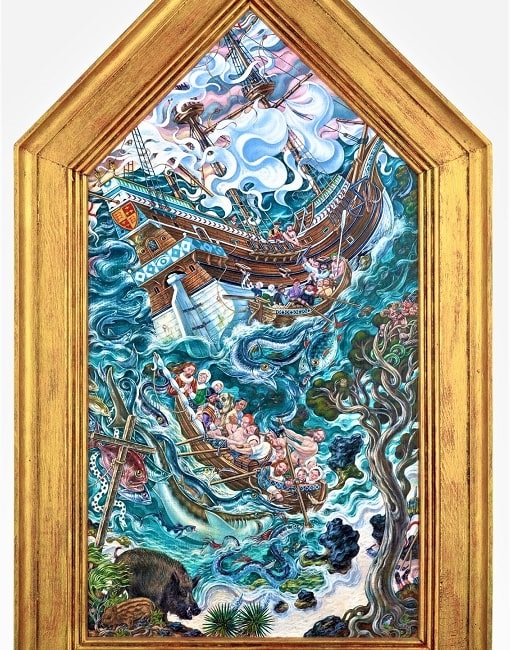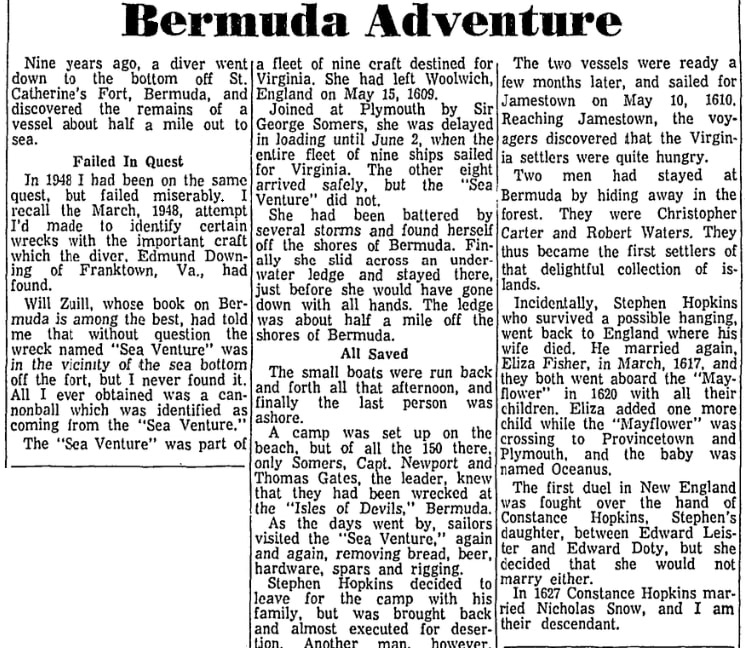Introduction: In this article, Melissa Davenport Berry begins the astonishing tale of Stephen Hopkins, a man who was shipwrecked in Bermuda, survived hardship in Jamestown, then later came back to the New World on the “Mayflower.” Melissa is a genealogist who has a blog, AnceStory Archives, and a Facebook group, New England Family Genealogy and History.
Edward Rowe Snow (1902-1982) was noted to be “just about the best chronicler of the days of sails alive,” and still is considered to be a legendary storyteller. If there ever was a “tale of the sail” to astonish, it would be the story of the 17th century ship Sea Venture, a Virginia-bound ship which was hit by a fierce hurricane and was shipwrecked. Yet by some miracle, the 150 passengers and crew members all survived. It was one of the greatest rescues in history – and they did it all by themselves.

The Sea Venture was part of the Third Supply mission fleet of the London Company sent to reinforce the colony of Jamestown, leaving England on 2 June 1609. When the Sea Venture was separated from the others in the storm and severely damaged, the crew and passengers found themselves marooned on the uninhabited, so-called “Island of Devils”: Bermuda.
The castaways salvaged what they could from the wreck of the Sea Venture and managed to construct two small vessels, Patience and Deliverance, which finally made it to Jamestown in May 1610.
This story undoubtedly was of great interest to Snow, because his ancestor Stephen Hopkins – a colorful chap predominantly known for being a signer of the Mayflower Compact and for his role in Plymouth, Massachusetts – was among those shipwrecked passengers.
The salty saga of the Sea Venture inspired Shakespeare’s play The Tempest. According to sources, passenger William Strachey recorded the events – and when his manuscript reached England it was passed around the court.
It is believed that once the story was in the hands of Henry Wriothesley, Earl of Southampton, treasurer of the Virginia Company and a staunch patron to Shakespeare, the drama was all there for the playwright.
In 1967 Snow announced that he would be traveling to Bermuda to “carry out final investigations on the unusual career of his ancestor Stephen Hopkins, a piratical mutineer, who was aboard the Sea Venture, wrecked at the so-called Island of Devils in 1609.”

Snow wanted more details of his ancestor’s activities between 1610-1617, which covers his stint in Virginia and return to England before he would sail aboard the Mayflower in 1620. He also hoped to find more genealogical information.
Here is one of Snow’s columns entitled “Bermuda Adventure” from November 1967 that tells the story of the Sea Venture.

Snow wrote:
Nine years ago, a diver went down to the bottom off St. Catherine’s Fort, Bermuda, and discovered the remains of a vessel about half a mile out to sea.
In 1948 I had been on the same quest, but failed miserably. I recall the March 1948 attempt I’d made to identify certain wrecks with the important craft which the diver, Edmund Downing of Franktown, Va., had found.
Will Zuill, whose book on Bermuda is among the best, had told me that without question the wreck named “Sea Venture” was in the vicinity of the sea bottom off the fort, but I never found it. All I ever obtained was a cannonball which was identified as coming from the “Sea Venture.”
The “Sea Venture” was part of a fleet of nine craft destined for Virginia. She had left Woolwich, England, on May 15, 1609. [Passenger list: Americana-Archives]
Joined at Plymouth by Sir George Somers, she was delayed in loading until June 2, when the entire fleet of nine ships sailed for Virginia. The other eight arrived safely, but the “Sea Venture” did not.
She had been battered by several storms and found herself off the shores of Bermuda. Finally, she slid across an underwater ledge and stayed there, just before she would have gone down with all hands. The ledge was about half a mile off the shores of Bermuda.
The small boats were run back and forth all that afternoon, and finally the last person was ashore.
A camp was set up on the beach, but of all the 150 there, only Somers, Capt. Newport, and Thomas Gates, the leader, knew that they had been wrecked at the “Isles of Devils,” Bermuda.
As the days went by, sailors visited the “Sea Venture,” again and again, removing bread, beer, hardware, spars, and rigging. [Note: the ship sat atop the reefs off Gate’s Bay long enough to be stripped of all useful parts and materials.]
Stephen Hopkins decided to leave from the camp with his family, but was brought back and almost executed for desertion. Another man, however, Henry Paine, struck a captain of the army in the face, and was executed for this.
To be continued…
Note: Caleb Johnson, historian, and author of “Here Shall I Die Ashore: Stephen Hopkins-Bermuda Castaway, Jamestown Survivor, and Mayflower Pilgrim,” notes that Hopkins organized a mutiny against the current governor. He held some weight as a minister’s clerk [the Rev. Richard Ruck], and made legal as well as scriptural arguments that the governor did not have authority over them since they were in Bermuda, not Virginia. The mutiny was discovered and on January 24 Hopkins was apprehended and sentenced to death. Some in the group defended him, but it was his own plea of his case, done with much sorrow and tears, “So penitent he was, and made so much moan, alleging the ruin of his wife and children in this his trespass, as it wrought in the hearts of all the better sorts of the company.”
Explore over 330 years of newspapers and historical records in GenealogyBank. Discover your family story! Start a 7-Day Free Trial
Note on the header image: rebuilding new ship from the timber and materials of the “Sea Venture” in Bermuda. Courtesy of thebermudian.com
Related Article:
- Mayflower Descendants: Who’s Who, Part 31 (part 2) (about Pilgrim John Howland)
